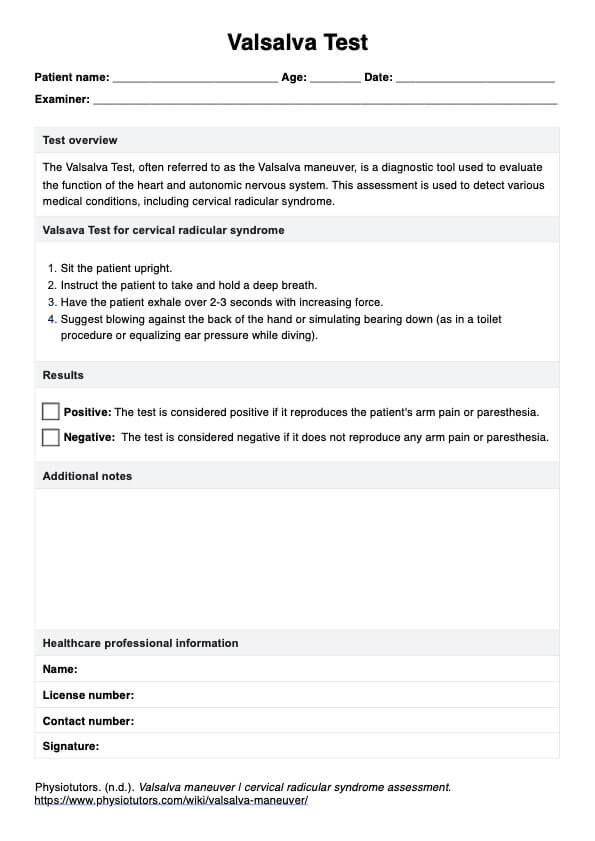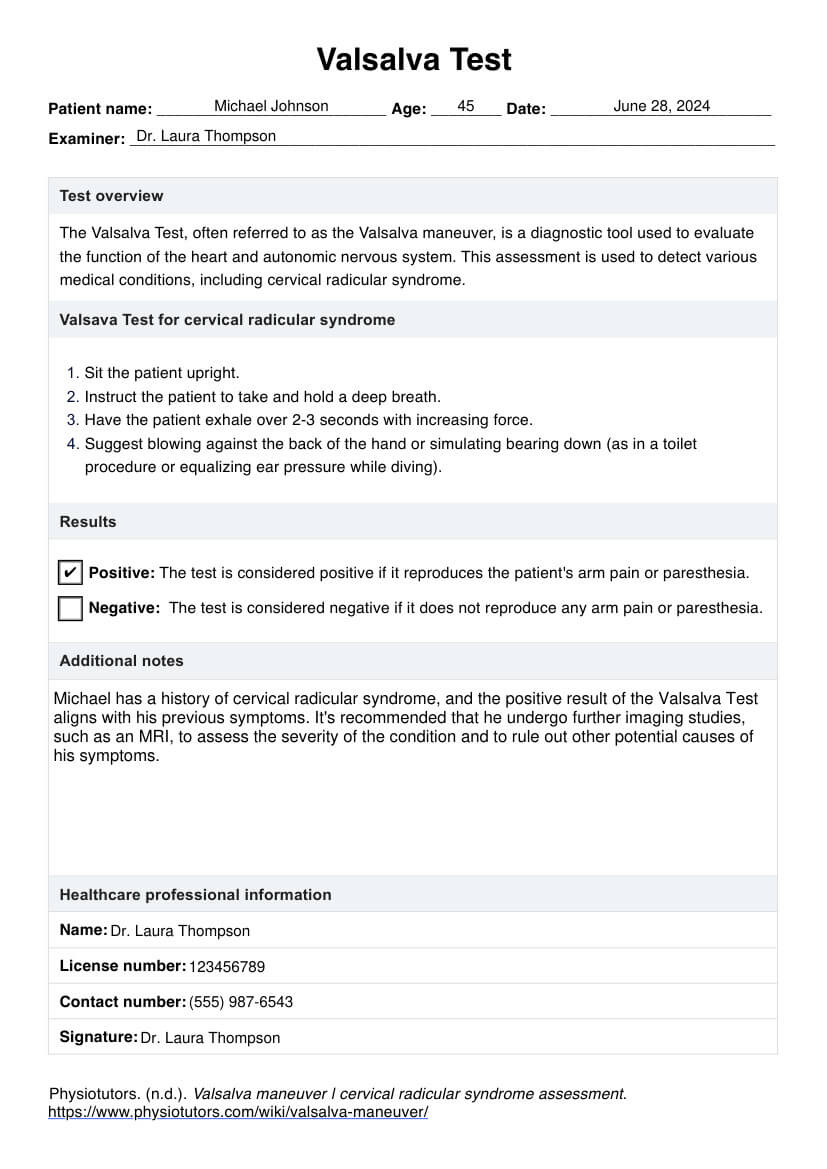Valsalva Test
Comprehensive guide on the Valsalva Test: understand cervical radicular syndrome, conduct the test, interpret results, and download our free template for accurate data collection.


What is cervical radicular syndrome?
Cervical radicular syndrome is a condition that arises when a nerve in the neck (cervical spine) becomes irritated or compressed, leading to pain that radiates from the neck into the shoulders, arms, and hands.
This condition is often associated with changes in blood vessels and blood pressure. For instance, an increase in intraspinal pressure can alter the blood pressure response, sometimes leading to an overshoot in blood pressure when blood rushes to the affected area.
If left untreated, cervical radicular syndrome can lead to chronic pain and difficulty performing daily activities. Therefore, early diagnosis and treatment are crucial for managing this condition.
Symptoms of this syndrome
Individuals with cervical radicular syndrome typically experience:
- Sharp, shooting pain in the neck, shoulder, arm, or hand
- Numbness or tingling sensations in the affected areas
- Muscle weakness in the arm or hand
- Reduced range of motion in the neck
- Pain that worsens with certain neck movements
In certain cases, techniques such as carotid sinus massage can be employed to help manage symptoms, particularly when supraventricular tachycardia, a type of fast heartbeat, is present. Additionally, fluctuations in intra-abdominal pressure may also influence the severity of the symptoms experienced. Proper diagnosis and management are key to alleviating the discomfort caused by cervical radicular syndrome.
Causes of this syndrome
The primary causes of cervical radicular syndrome include:
- Herniated discs: When the soft inner gel of a spinal disc bulges out and presses on a nerve root.
- Bone spurs: Bony overgrowths that can pinch nerves.
- Degenerative disc disease: Age-related wear and tear on spinal discs.
- Spinal stenosis: Narrowing of the spinal canal that puts pressure on the nerves.
Valsalva Test Template
Valsalva Test Example
What is the Valsalva Test?
The Valsalva Test, often referred to as the Valsalva maneuver, is a diagnostic tool used to evaluate the function of the heart and autonomic nervous system. It involves forcibly exhaling against a closed airway, which increases intra-abdominal and intrathoracic pressure.
The Valsalva maneuver is divided into four phases (Srivastav et al., 2020):
- Phase I (start of forced expiration): There is an initial increase in blood pressure and decrease in heart rate due to the increased intrathoracic pressure.
- Phase II (continuous straining): There is a decrease in venous return to the heart, causing a drop in blood pressure. This triggers a compensatory increase in heart rate mediated by the sympathetic nervous system.
- Phase III (release of respiratory strain): There is an abrupt decrease in intrathoracic pressure, causing a transient decrease in blood pressure.
- Phase IV (immediately after release): There is an overshoot in blood pressure above baseline levels. This triggers a rapid, reflex-mediated decrease in heart rate, mediated by the parasympathetic nervous system.
This test is used in various medical settings, including cardiology and neurology, to diagnose conditions such as cervical radicular syndrome, urinary incontinence, and cardiovascular autonomic neuropathy.
How is this test conducted?
Performing the Valsalva maneuver to detect cervical radicular syndrome involves the following steps:
- Position the patient in a sitting posture.
- Instruct the patient to take a deep breath and hold it.
- Ask the patient to exhale over a 2-3 second period with gradually increasing force.
- Suggest blowing against the back of the hand or simulating bearing down (like during a toilet procedure or equalizing ear pressure while diving).
- The test is considered positive if it reproduces the patient's arm pain or paresthesia.
This maneuver increases the intraspinal pressure, which can exacerbate any neuropathies or radicular pain, potentially indicating impingement on a nerve root by a disc or other anatomical structure. The Valsalva Test has been shown to have a sensitivity of 22% and a specificity of 94% in detecting cervical radiculopathy (Rubinstein et al., 2007)
Common treatments for cervical radicular syndrome
There are several effective treatments for managing cervical radicular syndrome, including:
- Physical therapy: Tailored exercises can strengthen neck and shoulder muscles, improve posture, and reduce pain.
- Medications: Pain relievers, anti-inflammatory drugs, and muscle relaxants can help manage symptoms and reduce inflammation.
- Epidural steroid injections: These injections target inflammation and pain directly, providing relief for many patients.
- Surgery: In severe cases, surgical intervention may be necessary to relieve nerve compression and alleviate symptoms.
Incorporating these treatments can significantly improve the quality of life for individuals suffering from cervical radicular syndrome. Always consult a healthcare professional to determine the most appropriate treatment plan based on individual needs and medical history.
References
Srivastav, S., Jamil, R. T., & Zeltser, R. (2020). Valsalva maneuver. PubMed; StatPearls Publishing. https://www.ncbi.nlm.nih.gov/books/NBK537248/
Rubinstein, S. M., Pool, J. J., Tulder, M. van, Riphagen, I. I., & Vet, H. de. (2007). A systematic review of the diagnostic accuracy of provocative tests of the neck for diagnosing cervical radiculopathy. InCentre for Reviews and Dissemination (UK). https://www.ncbi.nlm.nih.gov/books/NBK73918/
Commonly asked questions
Generally, it is safe for most people, but those with certain heart conditions should consult their doctor before performing the test.
It can be done at home, but it's best performed under medical supervision to ensure accurate results and safety.
The frequency depends on the patient's condition and the healthcare provider's recommendation.
Blood pressure overshoot refers to the temporary increase in blood pressure that occurs after releasing the Valsalva maneuver. This rebound effect is used to assess autonomic heart functions and can provide valuable diagnostic information.

.jpg)





































































































